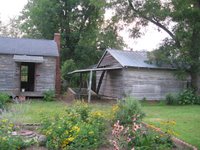A tree in our backyard began blooming beautifully last month. Its snowy flowers with pink edges and brilliant yellow stamens contrast its shiny, leathery leaves. A few flowers went to seed, which are tiny brown nuts. The crown goes down to the ground and covers a shrubby-looking trunk.




Identifying the classification of this tree proved to be challenging. When the owner of the tree service knocked down the trees too close to our house
last July, we asked him what this tree was and he had no idea. Over the weekend, Tammy tried to identify it with online biological keys. She looked for trees with flat, simple, alternating leaves, slightly toothed margins, no lobes, etc. She consulted several websites dedicated to trees in the Southeast:
Durham, North Carolina;
North Carolina Piedmont; and
Virginia Tech.
The Tree Identification for South Carolina did not have anything like our tree, so Tammy emailed them directly. Two foresters wrote her back right away and called it a
Camellia sasanqua. Tammy researched potential cultivars, and
Northern Lights seems to fit.
Well, that explains everything!
Camellia sasanqua is a
shrub, not a tree! She was truly barking up the wrong tree. Our "shrub" is about sixteen feet tall, but Camellias are only supposed to be as tall as
ten feet. Rarely do they ever reach
twenty feet! They are evergreens, so we will enjoy the dark green, leathery leaves year round.
Camellias, native to
Japan, did not arrive in Europe until 1869 via Dutch traders. The Japanese make tea with its leaves and tea oil out of its nuts or seeds. They sweetened the odor of tea by floating a single camellia flower floating in a cup of green tea. Its beauty and scent released the sorrow of the drinker. The camellia
symbolizes longevity, endurance, strength and eternal love.
One question we have is the age of the tree. The next time Tammy’s parents or we meet with the lady who grew up in the house, we plan to ask her. According to someone we contacted at
The American Camellia Society, several trees as old as one hundred years are scattered throughout the country. Could ours be one?
A camellia flower drops
And spills yesterday's rain.
-Yosa Bosun,
1717-1783
 To recap our adventures with brick, back in August 2006, our first mason repaired the foundation to our house and installed brand-spanking-new vents to the crawl space under the house. He also stuccoed the back chimney, but balked at the two front chimneys, which were in sad shape.
To recap our adventures with brick, back in August 2006, our first mason repaired the foundation to our house and installed brand-spanking-new vents to the crawl space under the house. He also stuccoed the back chimney, but balked at the two front chimneys, which were in sad shape.













